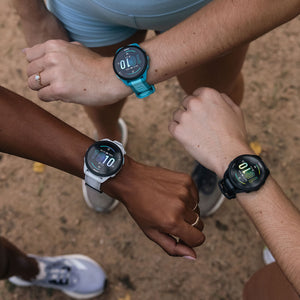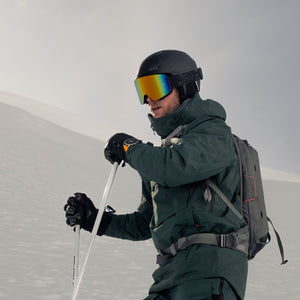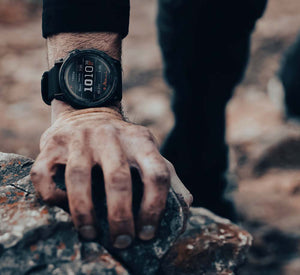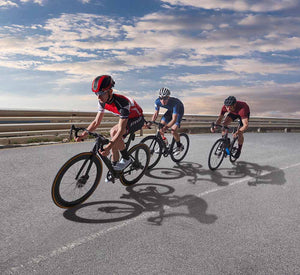
Suunto Race S vs COROS PACE Pro: The Big-Value Battle
The AMOLED-screen arms race is heating up. The Suunto Race S and the COROS PACE Pro are part of a growing selection of mid-priced sports watches that now pack impressive firepower behind a smartwatch-style screen. But which is best for your running needs?
It’s taken a little longer for Suunto and COROS to serve up GPS sports watches with brighter, sharper, more colorful AMOLED displays – the kind we saw land earlier on the best Garmin watches. But the Suunto Race S and the COROS PACE Pro both now offer that tech.
However, the Suunto watch and the COROS watch offer more than just a pretty face. Beyond the smartwatch-esque displays, the mid-range multisport trackers offer long battery life, accuracy-boosting dual-frequency GPS, navigation tools and a host of training, performance and health insights.
I spent months testing the new COROS watch and the new Suunto watch individually – and head-to-head – to tease out the differences on design and performance. If you’re wondering where to invest, I’m here to help you make the smart choice. Read on for my verdict in the Suunto Race S vs COROS PACE Pro review.
Suunto Race S vs COROS Pace Pro: An Introduction
The Suunto Race S and the COROS PACE Pro are two AMOLED-toting mid-range, mid-sized, multi sport watches both packing 30+ hour GPS battery life, offline mapping and some limited smartwatch tools.
The Suunto Race S is a compact alternative to the Suunto Race with a smaller AMOLED display, a 30-hour max-accuracy GPS battery life and all systems, dual frequency GPS. There’s also new heart rate sensor tech, a snappier user interface and some welcome new adventure tools.
The COROS PACE Pro sits between COROS’ cheapest, entry-level watch, the COROS Pace 3, and the more rugged COROS Apex 2. It also offers multiband GNSS and you get the same feature set as you’ll find on COROS’ more premium multisport watches. It’s relatively light and streamlined with a 31-hour max GPS battery life, an excellent 1,500 nit display that’s easy to read in all lights and brings your stats and maps to life.
The COROS PACE Pro offers the same sensor selection as the Vertix and Apex series, including ECG, barometric altimeter and spO2 sensor. The Suutno Race S doesn’t have ECG.
Both the COROS Pace Pro and the Suunto Race S offer the same 50 meters water resistance.
How I Tested
For this head-to-head review, I spent months wearing both watches individually. I also strapped them on for a few weeks side by side to dig deeper into the detail and the differences. I wore watches 24-7, while training, racing and sleeping.
I also put them up against the pricier Garmin fenix 8 and a Garmin HRM Pro+ chest strap to benchmark for comfort, accuracy, and battery life performance.
Models, Sizes & Prices
The Suunto Race S offers one stainless steel 45mm case size and seven different colours. There’s also a 45mm Titanium model with a lighter, more premium bezel. and three options: a Titanium Graphite, Titanium Courtney and Titanium Canary.
The one-size 46mm COROS PACE Pro comes in three colors: black, great and blue.
At launch, the COROS PACE Pro price and the Suunto Race S both landed at $349. That’s $100 cheaper than the MSRP for the Garmin Forerunner 265 and the Suunto Race which both come in at $449 and $50 cheaper than the Polar Vantage M3 at $399.95.
Meanwhile, the more premium Suunto Race S Titanium price is $449. Though you’ll pay a little extra for the Courtney special edition at $469.
Race S vs PACE Pro Design Comparison
On design, both watches keep things fairly simple, sporty but more streamlined and subtle than the bigger adventure watches. They use the same 1.3-inch displays and both are equally readable in all light conditions.
The Suunto Race S arguably looks more premium with a stainless steel bezel, a stronger, higher-performance plastic casing and a Gorilla Glass display. While the Race S uses less resilient mineral glass with plastic bezel and casing,
There’s not a huge amount to choose on wearability. The COROS is marginally thicker but notably lighter at 37g (with a nylon band) compared to 60g for the regular Race S or 53g for the Titanium. And you can easily swap straps on both with quick release.
One small point on design, the COROS charging cable is better than the Suunto which sometimes doesn’t feel quite as secure.
Suunto Race S vs COROS PACE Pro Price Summary
- Suunto Race S 45mm Stainless Steel – $349
- Suunto Race S 45mm Titanium – $449
- Suunto Race S 45mm Titanium Courtney special edition – $469
- COROS PACE Pro 46mm – $349
Other close rivals based on price and spec include:
- Polar Vantage M3 – $399.95
- Garmin Forerunner 265 – $449.99
- Garmin Forerunner 570 – $459.99
Suunto Race S vs COROS PACE Pro Battery Life
On paper, these two watches are closely matched for GPS staying power. The COROS PACE Pro battery life is listed at 31 hours using the Dual Frequency GPS. That rises to 38 hours in All Systems GPS mode. While the Suunto Race S battery life claims 30 hours using the Dual Frequency GPS. That rises to 40 hours in All Systems GPS mode.
There’s a bigger discrepancy in smartwatch mode. You get 9 days in smartwatch mode without the Always On screen from the Suunto but 20 days from the COROS. A lot of that is down to overnight tracking where the COROS is much more efficient.
In testing, the average overnight burn on the Suunto Race S Titanium was just 6-7% while the COROS PACE Pro was much more frugal at 2%.
A one-hour run with the COROS PACE Pro in max accuracy GPS mode burned just 2%. In the same settings the Suunto Race S Titanium burned twice as fast averaging 4% per hour.
During a 4-hour marathon using the max accuracy GPS, the Suunto Race S Titanium burned 15% (4hrs). We didn’t do a full marathon test with the COROS PACE Pro but we’d estimate around 8-10%.
For general usage with training, the Suunto Race S Titanium went 7 days with 5 hours GPS training. The COROS PACE Pro went 17 days with 7.5 hrs GPS training.
Running, Fitness and Health Features
In a nutshell, there’s more than enough tracking, training and health firepower on both watches to cater for most people’s needs. Running, cycling, swimming are well served and there’s triathlon mode to cater for the swim–bike-runners. So both would be a good option if you’re looking for a running watch, cycling watch or a triathlon watch.
Training and fitness insights include all the usual suspects to help you train smart, recover properly and manage your ongoing load. That includes training effect, training load, readiness and recovery estimates. There are also coaching plans, race-day pace and time predictions and interval workout tools.
Both watches track key daily wellness metrics like all-day heart rate, heart rate variability (HRV), stress, sleep quality, and blood oxygen (SpO₂), to help you keep tabs on how lifestyle choices and training affect recovery.
One major difference: the COROS offers ECG so you can take timed and intentional Heart Rate Variability reads but the Suunto doesn’t. The COROS PACE Pro supports temperature tracking, also missing on the Suunto.
Although they offer broadly similar training tools, Suunto’s language is a bit more acronym heavy. If you’re new to training data, things like TSS and CTL won’t mean much and it could certainly be more human. COROS isn’t immune to this either but probably does a better job of making the feedback more immediately user friendly.
Suunto Race S vs COROS PACE Pro Mapping and Navigation
The navigation smarts on both watches are fairly strong. Though not quite what you’ll get on the leading Garmin watches.
The COROS PACE Pro adds offline color topographical maps, brought to life by the bright AMOLED displays. We like that you can also use COROS’ unique extender mode to beam your watch screen to a smartphone for a better view.
The Suunto Race S has non-routable offline mapping, turn-by-turn navigation, with real-time prompts to guide your route. There’s a handy back-to-start tool in case you go too far off track in unfamiliar terrain.
You can create custom routes in the Suunto app and we like that the Race S also supports route import from platforms like Komoot.
You also now get a new ClimbGuide feature – Suunto’s version of Garmin’s excellent ClimbPro. Unlike ClimbPro, Suunto doesn’t yet let you see the specifics of climbs and descents up ahead on your route. Though mid-run or ride, you get a warning for the upcoming climb.
Smartwatch Tools
This is one area where COROS and Suunto still lag behind Garmin. They’re also no match for the life-taming features you’ll find on sports-friendly smartwatches like the Apple Watch Series 10 or the Apple Watch Ultra 2.
The COROS PACE Pro’s smarts include notifications from a paired smartphone. There’s offline music storage and phone-free playback. But you’ll need to own music files to make the most of that. There’s no Spotify support. There’s also no contactless payments or voice tools but you do get WiFi support and action camera controls.
The Suunto Race S also has the basics like notifications covered but there’s no offline music storage or Spotify support. Just music controls. No contactless payments or voice tools either. There’s more watch faces to choose from and some increased customization but we’re a way off Apple Watch territory.
Race S vs PACE Pro: Heart Rate and GPS Accuracy
The COROS PACE Pro and the Suunto Race S offer multiband/dual frequency GPS that aims to boost the accuracy of your sports tracking.
To test the GPS accuracy and heart rate reliability, I tested them head-to-head and with a selection of rivals, including the Garmin fenix 8 51mm AMOLED. I also used a chest strap for benchmarking.
I ran everything from built-up urban routes where watches tend to struggle, to tree-covered river paths and plenty of easier open roads and parks. I even spent some time in the sauna heat training to see how the heart rate performed at a lower intensity.
I switched up the power and accuracy modes from the multi-band GPS Max Accuracy, down to the Max Battery mode that sacrifices accuracy for staying power.
In testing, the GPS performance was solid on both watches. The dual frequency GPS performed well against the pricier Garmin fenix 8 for total distances and stuck us to tracks with good reliability.
Neither watch was 100% perfect. They both suffered occasional wobbles. But there wasn’t a major difference here that’d make one a better buy.
[GPS: Suunto–BLUE & GF8–BROWN & COROS–PURPLE ]
When it comes to heart rate, the Suunto Race S performance has improved over the Suunto Race. It coped well on steady runs but sometimes struggled with big changes of intensity, intervals and surges.
The COROS PACE Pro heart rate had the same occasional struggles, particularly during interval sessions, with some big spikes, at times reading 20bpm higher than a chest strap.
Again neither watch tracked the chest strap perfectly. The Suunto Race S had a tendency to surge with shifts in gear.
[HR CHART: Suunto Race S / HRM PRO / COROS PACE Pro]
All in all, you’re getting pretty standard optical heart rate performance from both watches and these are up there with the best running watches when it comes to accuracy overall.
Bottom Line: Should You Buy the Suunto Race S or the COROS PACE Pro?
The Suunto Race S is one of the best Suunto GPS watches we’ve seen for a while. The COROS PACE Pro is up there with the best COROS GPS watches. And if you’re trying to choose between them, you’ve got two very capable, good value multisport watches here. Both offer plenty of bang for buck that can seriously rival the pricier Garmin watches – like the Forerunner 265. Great if you want a broad suite of features on a tighter budget.
Choosing between them is tricky. In many areas they perform largely on par with a similar suite of training, tracking, health and smartwatch tools, generally good GPS battery life performance, bright AMOLED displays, comparative comfort, and not much to choose on heart rate and GPS accuracy.
The decision might come down to aesthetics. For my money, the Suunto is a better looking watch with a more premium feel and some tougher durability.
Beyond that, the COROS wins out in a few key areas: it offers better battery life outside of training, you also get ECG and offline music. Though the lack of Spotify might make that feature less of a draw for some.
Suunto’s UI is also a bit more clunky than COROS and the training insights language is less user friendly. But that’s something you can learn to live with the more you use it.
If you’re considering an alternative COROS running watch, the COROS PACE 3 offers similar training tools and insights, just without the AMOLED display. In terms of an alternative Suunto running watch, the new Suunto Run now offers much of what you’ll get on the Race S but in a lighter, more affordable package.
About Journalist Kieran Alger
Co-founder of The Run Testers, Kieran Alger is an experienced journalist who has spent more than a decade testing running gear. Regularly found wearing four GPS running watches at once, if it claims to make you run better or enjoy running more, he has probably tested it. He's a borderline obsessed runner with more than 50 marathon and multiple ultra finishes. In 2022, he became the first person to run Europe's river Danube from sea to source, a measly 1,830 miles in 66 days. And still had time to test running gear.
Check him out on Instagram or his YouTube Channel!













